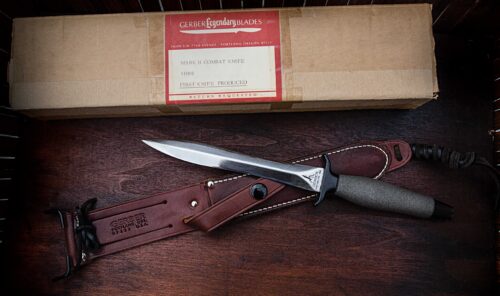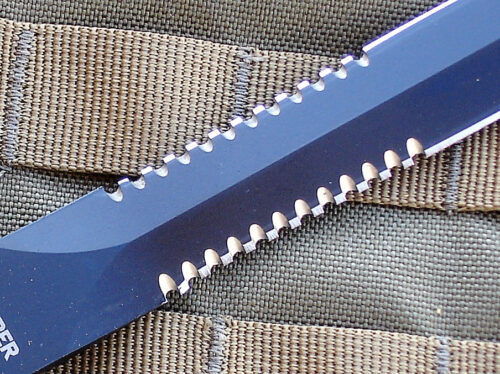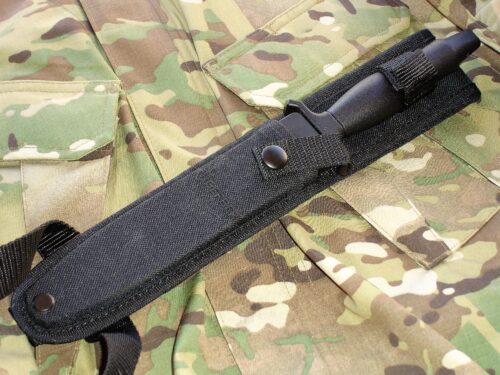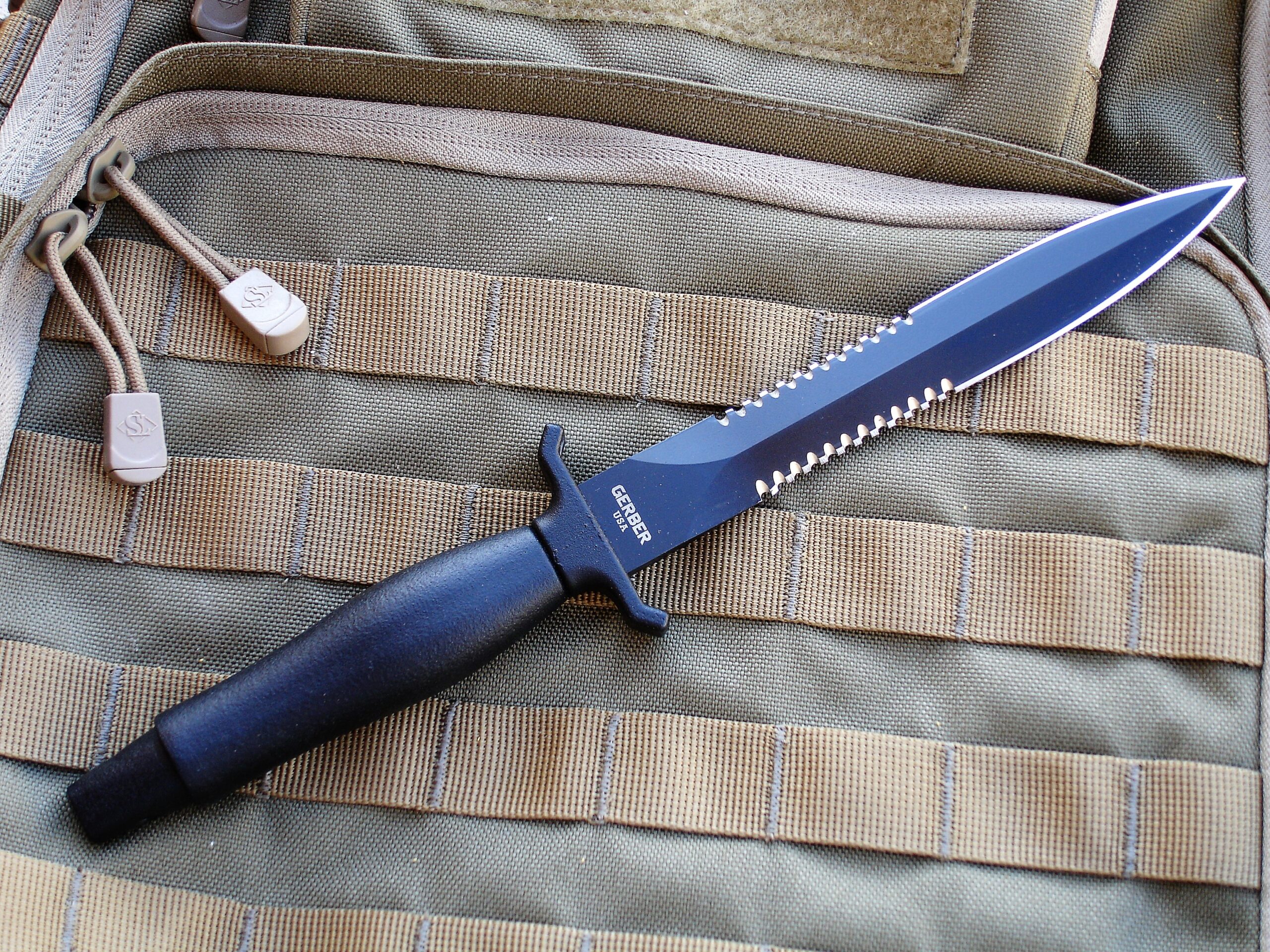The Gerber® Mark II™ was the iconic combat knife of the Vietnam War, much as the Fairbairn-Sykes (F-S) Fighting Knife (British Commando Knife), was the iconic combat knife of World War II. It’s one of the best selling knives of all time and continues to see action around the globe.
The Mark II was designed by retired US Army Captain Clarence A. “Bud” Holzman, who served with the 101st Airborne Division (“Screaming Eagles”) in the European theatre during WWII. Prototypes were field tested and evaluated at Fort Lewis, Washington by members of the Army’s Fourth Infantry Division.

Although Captain Holzman reportedly base the blade profile of the Mark II on the Roman Mainz Gladius in the British Museum’s collection, the similarities to the F-S Fighting Knife are unmistakable. Like the F-S, the Mark II has a slender, double-edge spear-point / dagger blade for maximum piecing capability and a distinctive foil-like handle to enable many handling / gripping options.
The Mark II went into commercial production in late 1966. Production continued until 2000, with an additional limited production run of 1,500 knives in 2002. Full production resumed in 2008 and continues to this day.
There have been many variations in the Mark II throughout the years of its production. These include changes in blade steel, blade profile, blade serration, handle material and color. Fortunately for collectors, all Mark II knives, except the yellow-handled dive knives, are individually serial numbered, which makes dating easy. The 1970-1974 yellow-handled dive knives have no serial numbers.
The first production run of the Mark II was wasp-waisted and had a five-degree offset between the blade and the grip. The offset design was done so that the knife could be kept closer to the body when sheathed and to compensate for the natural bend of the wrist when the knife was held in the “fencing foil grip.” The canted blade led to a number of knives being returned to Gerber for having “bent blades.” Gerber discontinued the cant in subsequent production runs.
Serrations were added to the Mark II in the 1970s. Al Mar, who was working for Gerber at the time, added two inches of scalloped saw-tooth double serrations toward the hilt. According to some sources, this was done to make the knife more politically correct, while others say they were added as a result of suggestions from the field.

A serrated edge essentially cuts by tearing rather than slicing. This makes it much more efficient when cutting through fibrous or flexible material. A serrated edge can clear a cut and can start cuts in materials where it would be difficult to do so with a straight edge. A serrated edge is also functionally longer cutting surface, so it will hold up longer without needing to be resharpened. It also cuts better than a plain edge when dull. A major disadvantage of most serrated blades is that they are more difficult to sharpen, requiring a special sharpening tool.
When Gerber reintroduced the Mark II in 2008, the serrations were changed from the scalloped saw teeth to flat chisel-shaped teeth ground on the same plain as the blade edge. This allows them to be sharpened at the same time as the blade and makes sharpening a breeze.
The 2008 version has a die-cast aluminum handle with a textured black powder-coat finish and a 420HC stainless steel double-edge, straight-waist blade with a black oxide coating. The blade has a zero-degree cant. Blade length is 6.5 inches / 16.51 cm, blade thickness is 0.235-inch / 5.969 mm and blade witdth is 0.875-inch / 22.225 mm. Overall length is 12.75 inches / 32.385 cm and weight is 8.0 ounces.
Commercial knife makers like 420HC. 420HC is a martensitic 420 series stainless steel. The HC stands for “high carbon,” which means it can be brought to a higher hardness than 420. While 420HC is not a high-end stainless steel, it does produce a good knife steel with good corrosion resistance and fairly good edge holding ability. It’s a good choice when ease of sharpening and toughness are important. It can be sharpened tom a very fine cutting edge and has excellent corrosion resistance.
Although a variety of handle materials have been employed for the Mark II, the majority are die-cast aluminum. The handle on the 2008 version is a one-piece solid A380 aluminum alloy casting that includes the guard, grip and pommel in a single piece. A380 is one of the most commonly specified alloys for die casting, as it offers the best combination of casting, mechanical, and thermal properties.

The handle on the Mark II is 5.25 inches long and has a flattened oval cross-section and tapered palm-swell design. Other handle features are an angled-forward double guard and a tapered pommel with lanyard hole. The handle was designed to be an effective yawara. The handle ergonomics of the Mark II are generally considered superior to those of the F-S Fighting Knife. The Mark II has outstanding balance And is lively in the hand. As is the case with the F-S, the Mark II is a purpose-built combat dagger with excellent penetration and reach.
A surprising variety of sheaths have been associated with the Mark II. The first sheaths were leather. Black ballistic nylon sheaths were introduced around 1985. The 2008 version ballistic nylon sheath has an injection-molded hard polymer liner and two nylon straps with snap closures for primary and secondary retention to secure the handle. Designed for maximum versatility, the sheath features a multi-mount system with belt loops, nylon webbing leg strap with side-release buckle and is MOLLE/PALS compatible. It’s fully jumpable.
The Gerber Mark II has a suggested retail price of $115,00. It’s made in the USA at Gerber’s Portland, Oregon factory. It comes with a limited lifetime warranty in North America and a 25- year limited warranty outside of North America. The Mark II is a true classic that belongs in every knife collection. It’s old school cool. And it’s just as effective today at taking care of business as it was on the day it was introduced.
Source
Gerber
www.gerbergear.com
Product Specifications
Gerber Mark II
Manufacturer: Gerber
Model: Mark II
Length:12.75 in. / 32.385 cm
Weight: 8 oz. / 226.796 g
Blade Steel: 420HC Stainless Steel
Blade Length: 6.5 in. / 16.51 cm
Blade Style: Double-Edge Dagger, Double-Serrated
Blade Finish: Black Oxide
Handle Material: Die-Cast A380 Aluminum
Handle-Finish: Black Powder Coat
Sheath Material: Black Ballistic Nylon w/ Hard Polymer Liner
MOLLE/PALS Compatible: Yes
Jumpable: Yes
Country of Origin: USA
Warranty: Limited Lifetime Warranty (North America); 25-year Limited Warranty Outside North America.
MSRP: $115.00
Follow our regular channel at Spotterup on YouTube https://www.youtube.com/channel/UC1PXrpGGfAUtZC6IVhXg2-w
Follow our site at https://spotterup.com/
Follow on Instagram as https://www.instagram.com/spotterup/
Visit my store at https://spotter-up.myshopify.com/
Material Disclosure
I received this product as a courtesy from the manufacturer so I could test it and give my honest feedback. I am not bound by any written, verbal or implied contract to give this product a good review. All opinions are my own and are based off my personal experience with the product.
*The views and opinions expressed on this website are solely those of the original authors and contributors. These views and opinions do not necessarily represent those of Spotter Up Magazine, the administrative staff, and/or any/all contributors to this site.


Hi!
Loved your article on the Mark II—you didn’t repeat the same things that everyone else reprints. Nice to know. I have a question for you and I’m wondering if you’d respond to my private email? I’d like your opinion on something.
Thanks and keep up the good work!
Kasey
i have a newer markii and the serial number is 25235 and below that it states code 17aln then below it says 0870618g. I was wondering if you might be able to help me out with this. Thanks in advance
Per Gerber “The alpha-numeric number found on products manufactured from 2013 and forward, identifies the time period your product was produced. It does not identify the product itself and does not include the model number of your product.” For additional info I suggest you contact Gerber Customer Service.